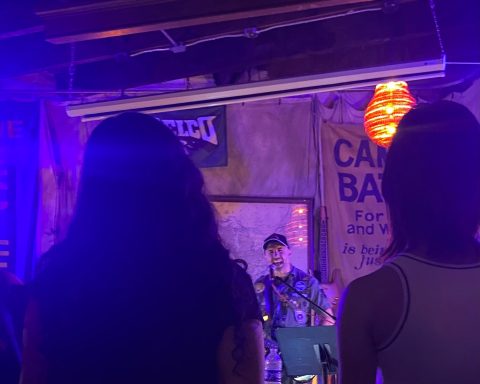Editor’s note: This article was initially published in The Daily Gazette, Swarthmore’s online, daily newspaper founded in Fall 1996. As of Fall 2018, the DG has merged with The Phoenix. See the about page to read more about the DG.
The story opens with a dead woman. She’s naked, posed, possibly mutilated. Something vaguely ritualistic has been done to her body or to the area where she’s been placed. Male law enforcement officers examine the scene, horrified.
If you want to make a prestige television show about murder, there’s your opening. Despite being overused, it’s quite successful: it’s how “True Detective” began, and there’s been no small amount of praise for the show. The formula works, but if you, like me, have grown tired of mistreated women being discussed by men, you won’t be thrilled with it.
There has been a lot said about the misogyny of “True Detective“ (or is it a commentary on misogyny?) but I’ve come to realize the show’s fondness for displaying desecrated female bodies is not unique. “Hannibal” has been doing the same – right on down to the antlers – for a year. “The Following” also pairs murder with literary posturing, going as far as quoting Poe’s claim that there’s nothing more poetic than the death of a beautiful woman.
Many of these shows have received critical praise for being dark, complicated, and fresh, but centering a story on a brilliant, sadistic man while failing to give a voice to the women he is hurting is not an inventive choice. At this point, it’s kind of tired.
This isn’t to say that creators should not tell stories about violence or evil. But the stories that currently explore those themes have a habit of turning women – dead and alive – into decorative objects who are only relevant when violence is inflicted upon them. The shows do not endorse rape or murder, but their cameras do linger over the images of abused women in a way that makes you wonder what lengths networks will go to fill their weekly nudity quota.
“True Detective” creator Nic Pizzolatto mentioned on Twitter that short-shrifting female characters is “one of the detriments of only having two [point of view] characters, both men”, but that excuse is not very credible. Shows with male protagonists are fully capable of featuring well-developed female characters.
NBC’s “Hannibal,” in a distinct departure from its source material, features quite a few supporting women (Alana Bloom, Freddie Lounds, Abigail Hobbs, Bella Crawford), even though Hannibal Lecter and Will Graham are the stars of the show. Hobbs and Crawford, a daughter and a wife, had entire episodes devoted to their stories. These women are not the forefront of the show, but the audience is given glimpses into lives that are fully developed and independent of the leading men.
Of course, Hannibal’s central theme is not violence against women. But a work can address misogyny without being misogynistic itself. Gillian Flynn seems to have made a career out of it. All three of her best-selling novels (Dark Places, Sharp Objects, Gone Girl) are about violence against women, and all feature women as the protagonists. Her latest, Gone Girl, is narrated by both a missing woman and her (possibly guilty) husband. Instead of voicing only the victim or perpetrator, Flynn gives each a voice, and then lets the reader make a choice. It’s more than possible to have both voices exist – if you want your story to have gravity, it’s vital.
As Alyssa Rosenberg recently said on the topic at ThinkProgress, asking shows like “True Detective” to flesh out their female characters at least as much as their male ones is not an attempt to “redistribute the precious minutes of prestige television” in the name of feminism: it’s a reminder that if you are making a show about violence and evil, it’s a far more interesting choice to have real victims – victims with thoughts, lives, and souls – rather than women who were lifeless even before they were corpses.
Featured image from bloguin.com.

















Nice piece. Did you have to pay Emily Nussbaum a flat fee to rip off her New Yorker article from three weeks ago, or is it a sort of “pay-per-page-hit” type of deal?
Hey Tom –
Nussbaum’s article was awesome, which is why I linked it in the third paragraph (I also linked Willa Paskin’s less-awesome Slate’s piece). But since they were written earlier than Nic Pizzolatto’s (since deleted) tweet claiming well-formed female characters would be impossible to include in a show with two leading dudes, neither could address it specifically. I wanted to bring Hannibal into the conversation as a contrast, since it’s a show that has a myriad of supporting women and does not feature sexual violence. I’m also a huge fan of Mads Mikkelson.
Keep checking back for more on Hannibal – I hope my season 2 piece will be reminiscent of Matt Zoller Seitz’s coverage.
Thanks for reading,
Allison Hrabar
Staff Writer
The Daily Gazette
All issues well worth repeating sir. Since most people boiled down Nussbaum’s complaint to feminists demand for ‘strong” female characters there is a lot of extremely disturbing material that gets missed. Particularly the use of real world women’s issues used as plot device to prop up main characters, then women treated as sexual decor, their suffering a mere backdrop. Oh yeah, all female orifices covered in a mere 8 episodes including ‘Skullfu**ing’, rampant dehumanizing nudity (no faces/heads), some type of ass fetish, indulgent depictions of prostitution, all female characters sexualized including children, non sexed females are gnarled with headaches, memory loss, munchausen, incest and some form of mental retardation. A decent female character against all of this would have portrayed humanity and compassion and contrast to the rest of the misogynistic material.